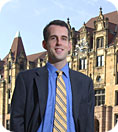 |
|||||||||
|
| home | our mission | contact us | issue archive |

Jul 2002 / church and state :: email this story to a friend

Putting Together the City's Tech Puzzle
By Amanda E. DoyleUnlike the rest of the walls in the warren of offices behind the door marked "Room 200," which exhibit a sort of dirty-eggshell hue, the two largest walls in Chris Dornfeld's office are a striking and soothing shade of china blue. Dornfeld, a special assistant to Mayor Francis Slay in charge of technology, decided early in his tenure that if he was going to be spending 80-hour weeks here, he might as well have something pleasant to look at.
Ten months into his assignment, it's still not crystal clear what he's gotten himself into. Before he was lured away by the city, Dornfeld had a high-profile (and lucrative) career at local technology company Access US. It was a job he had no intention of leaving.
"When the current administration came in, they recognized our great need as a city to use technology in a much more significant way," Dornfeld said. "I was approached by Barb Geisman and Jeff Rainford, who asked if I would lend my thoughts to what a new technology coordinator position should look like."
Photo: St. Louis Business Journal In a sense, the Slay administration was making it up as they went along, since such a position was a new one for the city. Dornfeld's advice hinged on a holistic view of what technology could do to improve the city: "Don't weight all your decision purely on technical background. The deciding factor for this job shouldn't be finding who's the best computer programmer." He rightly surmised that a systemic change would require skills in business and management, not just great computer chops.
After a few conversations, members of the administration asked him if he'd be interested in taking on the position he helped design. He remembers feeling happy and flattered, but unsure as to why he should jettison his career trajectory (a tech executive succeeding in private enterprise) to take on the challenges of government service.
"But the more I thought about it and talked to others, the more I knew that this was too interesting of an opportunity, one that I would forever regret if I didn't take it," he said. "It's like I had spent all these years studying mountain climbing, talking about the need to climb the mountain, making plans to climb, and now someone was throwing down the gauntlet and saying, 'It's time to climb.'"
Time spent in philosophical discussions of how to influence the city towards positive change, with friends and in groups like Metropolis, came to fruition in this opportunity. After a frank, one-on-one discussion with the mayor (whom he'd met briefly only a few times), Dornfeld decided the rubber had met the road. He agreed to a year-to-year position (with an annual review with the mayor to ensure mutual satisfaction), and took a job funded largely by contributions from the Civic Progress companies.
The rumors of the city's abysmally backward technology have not been much overstated. Nearly every bureaucracy has its own information processing system, with a group of users who know only how to keep their outdated end of it running, and no way to effectively share information across departments.
"There are a lot of offices using software that's a decade old, seventeen years old," Dornfeld said. "Seventeen years in terms of technology...it's like dog years! There's no way that can continue to exist."
For example, when citizens call in complaints to the Citizens' Service Bureau, their information is entered into the CSB's computer system and the caller is assigned a work order number. At the end of each day, CSB has one or two employees whose entire job is to print out copies of the work orders and walk them over to, say, the Forestry Department, where the hard copies are transcribed into the Forestry Department's computer system. (It can't talk to the CSB's.) Forestry assigns the same file a new work order number, so that the original paperwork has been strictly duplicated.
The city's 28 aldermen, most of whom are set up to receive e-mail sent by constituents directly from the city's web page, don't actually "receive" e-mails at all, at least not in electronic form. It's the responsibility of their secretary to collect and print out all the e-mails they receive, then deliver a stack of "e-mails" to the aldermen.
When understood in those terms, suddenly the cost of integrating the city's technology efforts under the auspices of a single overseer (i.e. Dornfeld) doesn't seem so out of reach. "It's a serious case of redundant work, literally the same thing being done several times by several people, and that's time and money that could allow those people to be delivering services better," he said. "Most people want to be a part of something they can be proud of, so when I put it in terms of, 'Hey, instead of retyping work orders, what if those two people were freed up to make follow-up phone calls about the services the CSB provides, and see how it worked out when you asked them to trim a problem tree,' it really captures the imaginations of people." The public, too, might have their imaginations captured (or at least not feel compelled to make so many complaining calls) if the time to do customer service right became a larger part of the government picture. Dornfeld says the frustration of city employees is palpable: "Everyone goes home and uses a better e-mail system than we have here."
So, fixing it all sounds great, right? Well, not to everyone. As in any large organization, plans and rumors of a technology consolidation plan have caused an uproar among the well-defined fiefdoms that so many bureaucrats have carved out for themselves. Left to fend alone in the tech wilderness for so long, many heads of departments think that only they truly understand the needs and capabilities of their areas, and are reluctant — if not downright hostile — to relinquish the reins, particularly to the mayor's young gun. "I can't tell you how many people have actually said to me, 'You're not my boss, so I don't have to work with you at all on this,'" Dornfeld said.
The city comptroller, too, has expressed grave concerns over the wisdom of moving the city's technology and communications systems into one reporting structure, which ultimately would lead straight to the mayor, instead of the current oversight of the three-member Estimate and Apportionment Board. She was quoted last month as saying it was "little more than a poorly thought out political move."
Dornfeld insists the only motive for consolidation is to improve the quality of life for everyone. He's spent a large chunk of time lately researching 25 other large cities' technology plans — places like Tampa, Detroit, New York City, Boston, Kansas City and so on — and in every case, he says, the technology is consolidated and is directly accountable to the mayor.
He remains convinced that the only way for St. Louis to remain viable is to remake its house from the inside, in order to project an image that the city is a going concern, and an attractive option for high-tech companies and young, skilled, creative workers. "We can't go out and say, 'Hey, look, St. Louis is cutting-edge and fast-paced,' if our own government is old and slow moving and bureaucratic," he said.
On a white board on his office wall, the equation "St. Louis = Emerging Market" is an omnipresent reminder that our city is far behind other hot spots, but has only growth opportunities ahead. "Fifteen years ago, what was Austin? What was Seattle?" Dornfeld asks. "We have the opportunity now to look around at the very best examples in every city and cherry-pick the best models from each one."
At the end of June, Alderman Terry Kennedy refused to move forward a large technology bill that Slay and Dornfeld will need passed to implement their sweeping plan, citing a need for more details on the bill's effects. It's a good bet, though, that the administration will keep pursuing their vision for unified city technology.
"I think that in just a couple of years, you will see the results of a whole new approach," said Dornfeld, "and the overall result will be to change the whole culture of the organization and the city."
Church and State | Games | Expatriates | Communities | From the Source
It's All Happening | Young Minds | The Ordinary Eye | Elsewhere
Sights and Sounds | Media Shoegaze | A Day's Work | From the Editor© 2002 The Commonspace
